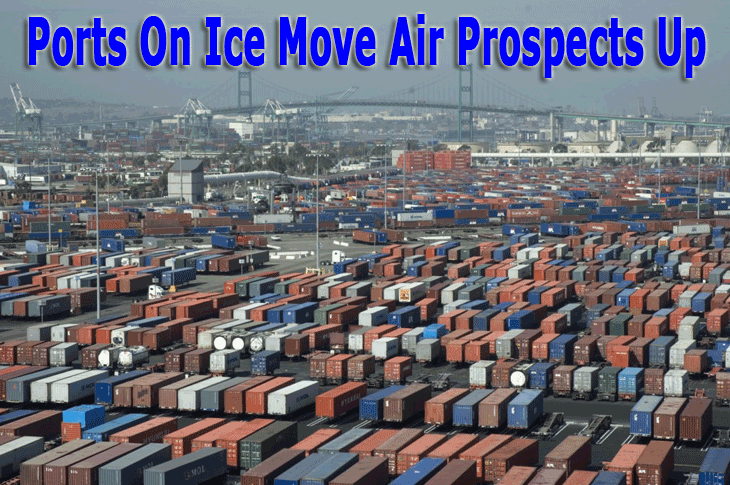

#INTHEAIREVERYWHERE

 |
 #INTHEAIREVERYWHERE |
 |
| Vol. 13 No. 94 | Monday
November 17, 2014 |
Ports
On Ice Move Air Prospects Up |
 So intractable are the problems now causing congestion at U.S. West Coast ports that demand for air freight could be boosted not just through Thanksgiving and Christmas, but also well into 2015. There is no escaping the astonishing mess and huge challenges facing U.S. ports and their shipper customers caught in a maelstrom of high demand, limited supply, and the inability of entrenched interests to see beyond their collective noses. Given the number of factors currently contributing to the delays that are now running to 21 days at some individual terminals, predictions by some analysts that air freight to and from the U.S. could see an elongated boom well into the first quarter of 2015 are not so far-fetched. So why is moving cargo via U.S West Coast ports so slow and unreliable? The causes are many and varied.  Firstly, looming over the logistics industry is the ongoing contract negotiations
between the International Longshore and Warehouse Union (ILWU) and the Pacific
Maritime Association (PMA) that began on May 15, 2014, and continue today,
despite the previous contract expiring on July 1. This has skewed shipping
patterns throughout the year, forcing retailers to import more cargo early
to avoid the threat of industrial action and pushing more shippers to use
East Coast and Canadian ports, or switch to air solutions.
Firstly, looming over the logistics industry is the ongoing contract negotiations
between the International Longshore and Warehouse Union (ILWU) and the Pacific
Maritime Association (PMA) that began on May 15, 2014, and continue today,
despite the previous contract expiring on July 1. This has skewed shipping
patterns throughout the year, forcing retailers to import more cargo early
to avoid the threat of industrial action and pushing more shippers to use
East Coast and Canadian ports, or switch to air solutions.In recent weeks, alleged union ‘go-slows’ at ports in the Pacific Northwest and threats of strikes have further choked up ports, and fears are now growing that a total shutdown of West Coast ports could happen if an agreement is not reached soon. Such is the gravity of the situation that earlier this month a huge array of shipper and transport associations addressed a letter to President Obama warning of the potential dire consequences and calling for mediation of the dispute. “The threat of a West Coast port shutdown is creating high levels of uncertainty in a fragile economic climate, which has forced many businesses to once again undertake contingency plans that come at a significant cost to jobs and our economic competitiveness,” said the letter. “The West Coast lockout 12 years ago cost the U.S. economy $1 billion a day. It took half a year for the ports to clear the backlog and recover from this 10-day shut down. A shutdown now could be even more costly.” Indeed, a study by the National Association of Manufacturers and the National Retail Federation estimated the economy would lose nearly $2 billion each day of a five-day interruption, so the stakes are high. However, the current congestion being suffered at U.S. ports is not a simple matter of labor relations. U.S. ports are a long way from world-leading in terms of infrastructure or efficiency, while structural changes in the liner industry have also played their part in creating choke points. Another factor is the divestment of chassis by shipping lines, which is manifesting itself in a shortage of chassis inventory at the Port of Long Beach and other U.S. ports. “The situation could have been mitigated had the carrier community acted in greater alignment regarding chassis,” said Jason Bergman, senior vice president for Ocean & Truck Transportation at BDP International. He claimed that driver and truck shortages were also now a “brutal reality” that supply chain managers had to work around. “While wages have been rising to attract drivers, compensation structures—specifically for drayage—are tied to shipment/load volumes and asset utilization,” he said. “If a driver is sitting in a cab waiting for hours outside a port terminal in traffic to pick up a shipment, and he or she is not adequately compensated for the time, therein lies the challenge. “All of these factors are contributing to port congestion and long delays for drayage companies waiting up to five hours at port entry gates to pick up containers. The result? Fewer asset turns per day—as low as one to three turns per day versus the four to five needed for the trucker to earn sufficient income.” The equipment and labor crunch has come on top of ongoing supply chain flaws. “The winter Polar Vortex of 2013/2014—and ensuing frigid weather conditions—caused delays all through the supply chain, including reduced intermodal rail capacity,” said Bergman. “As a result some ports/hubs, such as Chicago, are still catching up. Consequentially, intermodal capacity on the West Coast has been impacted. There is very little a carrier can do when the culprit is Mother Nature.” The container shipping and port sector is also still trying to come to grips with the deployment of larger container vessels. “The new generation of mega-container ships with capacities of more than 16,000 TEUs is exacting added pressure on existing port infrastructures suited to smaller ships,” said Bergman. “Ports and terminals are challenged to build and expand infrastructure to handle both increased capacity and shipping volume.”  “The causes of the [West Coast] delays are numerous,” said John
Wierzbicki, (left) Country Head of Ocean Freight USA at Panalpina. “Higher
year-on-year volumes moving via the ports, chassis shortage/dislocation,
driver shortages, unprecedented ‘safety inspections’ for trucks
at the terminals slowing the pace of work, and recently labor shortages
[at terminals].”
“The causes of the [West Coast] delays are numerous,” said John
Wierzbicki, (left) Country Head of Ocean Freight USA at Panalpina. “Higher
year-on-year volumes moving via the ports, chassis shortage/dislocation,
driver shortages, unprecedented ‘safety inspections’ for trucks
at the terminals slowing the pace of work, and recently labor shortages
[at terminals].”BDP is now advising customers to make contingency plans via weekly conference calls with peak season client shippers in the event disruption continues into 2015. Bergman believes the chassis shortage can be addressed relatively quickly. “Some shippers and truckers are already purchasing chassis,” he explained. “If this trend continues, it will improve overall conditions.” However, many of the other issues facing supply chain planners may prove intractable in the short and medium term, bringing alternative shipping solutions and other modes such as air freight more heavily into play in the weeks and months ahead. “We provide multi-port strategies including alternative ports, inland rail terminals where available, air freight options, and other options to keep cargo moving when difficulties arise,” said Bergman. “We are seeing an increase in air freight volumes with mode-shifting from ocean cargo to our large network of cargo airline partners in high demand markets. BDP is deploying the air option in concert with inland surface transportation for our clients to meet seasonal, time critical inventory demand.” Panalpina is taking much the same approach to avoid lengthy U.S. import and export delays. The company has started offering clients the option to trans-load containers to 53’ trailers at its warehouses on the U.S. West Coast for truck delivery to inland points in order to avoid rail delays and to expedite delivery of shipments that have been delayed at the ports, while at the same time freeing up drivers and chassis for local drayage. “We have also negotiated for exclusive use of chassis and drivers with our drayage providers to ensure consistent availability of both equipment and drivers to Panalpina, but even this option has a limited capacity,” said Wierzbicki. “At this point any product sold for Christmas is either in the clients’ U.S. distribution centers or on the way to stores. Any product to be imported for Christmas will now likely move via air, and we are seeing an increased demand for air capacity.” SkyKing |
If
You Missed Any Of The Previous 3 Issues Of FlyingTypers |